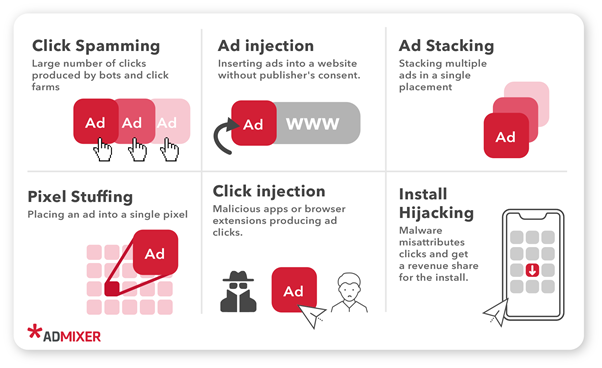What is Ad fraud? How to prevent it? [2024]
Last updated on March 28th, 2024 in Privacy
 Introduction to Ad Fraud
Introduction to Ad FraudAre your online advertising efforts falling victim to unseen threats? Picture this: you invest time, money, and creativity into crafting the perfect digital ad campaign, only to discover that a significant portion of your budget is being wasted on fraudulent activity.
This lurking danger goes by the name of ad fraud, a pervasive issue affecting businesses of all sizes in the vast realm of digital marketing.
Stay tuned as we delve into the world of ad fraud, uncovering its types, impacts, detection methods, prevention strategies, and the future landscape of safeguarding against this digital menace!
Ad fraud comes in various forms, each with its own deceptive tactics aimed at manipulating online advertising.
One common type is click fraud, where bots or individuals generate fake clicks on ads to drive up costs for advertisers. Another prevalent form is impression fraud, where impressions are falsely generated to make it seem like the ad was seen by more people than it actually was.
Similarly, conversion fraud involves faking conversions or actions taken in response to an ad to inflate performance metrics artificially. Domain spoofing occurs when fraudulent websites impersonate legitimate ones to trick advertisers into placing ads on their pages. Fake traffic and bot networks are also used to simulate human behavior and engagement with ads.
These types of ad fraud not only waste advertising budgets but also undermine trust in digital marketing channels. Recognizing these different methods is crucial for businesses looking to protect their investments and ensure genuine engagement with their target audience.
 Ad fraud poses a significant threat to both businesses and consumers in the digital advertising ecosystem. For businesses, falling victim to ad fraud can result in wasted advertising budgets, skewed performance metrics, and ultimately lower ROI on marketing investments. This not only impacts the bottom line but also erodes trust in digital advertising channels.
Ad fraud poses a significant threat to both businesses and consumers in the digital advertising ecosystem. For businesses, falling victim to ad fraud can result in wasted advertising budgets, skewed performance metrics, and ultimately lower ROI on marketing investments. This not only impacts the bottom line but also erodes trust in digital advertising channels.
Moreover, for consumers, ad fraud can lead to a poor user experience online. False advertisements or malicious redirects may expose users to scams, malware, or inappropriate content unknowingly. As a result, consumer trust in online ads diminishes while their overall internet browsing safety is compromised.
In essence, the repercussions of ad fraud reverberate across industries affecting stakeholders at every level of the digital advertising supply chain. It’s crucial for businesses and consumers alike to stay vigilant against this pervasive threat by implementing robust prevention measures and leveraging advanced technologies designed to combat fraudulent activities effectively.

Ad fraudsters are constantly evolving their techniques to deceive advertisers and siphon off advertising budgets.
One common method used in ad fraud is click spamming, where bots generate fake clicks on ads to inflate performance metrics. These fraudulent clicks appear legitimate but do not represent genuine user engagement.
Another prevalent tactic is ad stacking, where multiple ads are placed on top of each other within a single ad placement. This makes it impossible for users to see the actual ads while still registering as views or clicks. It’s a sneaky way for fraudsters to trick advertisers into paying for impressions that aren’t seen by real users.
Moreover, domain spoofing involves misrepresenting the website where an ad is displayed to make it seem like a premium site with high traffic when, in reality, it’s a low-quality or even fake website. Advertisers end up overpaying for placements on websites that don’t deliver the expected results.
To combat these deceptive practices effectively, advertisers need to stay vigilant and leverage advanced technologies such as machine learning algorithms and AI-powered tools that can detect anomalies in traffic patterns and identify suspicious activities before they impact campaign performance significantly.
Detecting and preventing ad fraud is crucial for businesses to protect their investments and maintain trust with consumers.
One way to detect ad fraud is by analyzing traffic patterns on your ads – look out for suspicious spikes or irregularities that could indicate bot activity. Utilize tools like click verification services to validate clicks and ensure they are coming from legitimate sources. Implement strict targeting criteria to reach the right audience, reducing the risk of fraudulent clicks.
Regularly monitor key performance indicators (KPIs) such as conversion rates and click-through rates to identify any sudden drops or anomalies that may point towards ad fraud. Collaborate with industry experts and participate in forums or webinars focused on ad fraud prevention to stay updated on the latest trends and techniques used by fraudsters.
Consider investing in anti-fraud technologies like machine learning algorithms that can proactively flag potential instances of ad fraud before they impact your campaigns significantly.
Educate your team members about common forms of ad fraud so they can be vigilant when managing advertising campaigns. Stay informed about emerging threats in the digital advertising landscape and adapt your strategies accordingly to mitigate risks effectively.
By staying proactive, and vigilant, and leveraging advanced technologies, businesses can safeguard their online advertising efforts against potential fraudulent activities efficiently.
 When it comes to combating ad fraud, having the right tools and technologies is crucial.
When it comes to combating ad fraud, having the right tools and technologies is crucial.
One effective tool is the use of fraud detection software that can analyze traffic patterns in real-time to identify any suspicious activity like Wireshark. These tools can help businesses detect fraudulent clicks, impressions, or conversions before they impact their advertising campaigns.
Another technology that has proven to be valuable in preventing ad fraud is AI-powered algorithms. By leveraging machine learning and artificial intelligence, these algorithms can continuously learn from data patterns and quickly adapt to new forms of fraudulent activities. This proactive approach enables businesses to stay one step ahead of fraudsters.
Blockchain technology is also gaining traction in the fight against ad fraud. By creating transparent and secure digital ledgers for tracking transactions, blockchain helps verify the authenticity of ad placements and ensures that advertisers are getting what they pay for.
Additionally, utilizing third-party verification services can provide an extra layer of protection against ad fraud by independently monitoring campaign performance and validating the quality of traffic sources. These services offer detailed insights into campaign effectiveness while flagging any signs of fraudulent activity for immediate action.
Investing in advanced tools and technologies tailored for preventing ad fraud is essential for safeguarding advertising investments and maintaining trust with consumers.
As technology continues to advance, the future of ad fraud prevention looks promising. With the development of sophisticated algorithms and machine learning capabilities, advertisers can now detect fraudulent activities more effectively.
One exciting trend in ad fraud prevention is the rise of blockchain technology. By utilizing decentralized ledgers, advertisers can ensure transparency and traceability in the digital advertising ecosystem, reducing the risk of fraudulent practices.
Additionally, artificial intelligence (AI) plays a crucial role in identifying patterns and anomalies that indicate potential ad fraud. As AI algorithms become more advanced, they can quickly adapt to new tactics used by fraudsters, staying one step ahead in the battle against ad fraud.
Moreover, collaboration among industry players will be key in combating ad fraud collectively. By sharing data and insights on fraudulent activities, advertisers can build a stronger defense mechanism against malicious actors within the digital advertising space.
Another mechanism of prevention that has proved to be of help is using VPN service, many come with ad blocks and filters that keep you away from trouble and make sure you are anonymous online.
As technologies evolve and collaborations strengthen, the future of ad fraud prevention holds great promise for creating a safer and more trustworthy digital advertising environment for businesses and consumers alike.
Ad fraud is a persistent threat in the digital advertising ecosystem, impacting businesses and consumers alike. As technology advances, so do the tactics used by fraudulent actors to deceive advertisers and siphon their budgets. To combat ad fraud effectively, it’s crucial for businesses to stay vigilant, educate themselves on the types of fraud, and invest in tools and technologies that can detect and prevent fraudulent activities.
By understanding how ad fraud works, implementing robust detection measures, utilizing anti-fraud solutions, and collaborating with industry partners to share insights and best practices, businesses can mitigate the risks associated with fraudulent activities.
As we look towards the future of ad fraud prevention, continuous innovation will be key in staying ahead of increasingly sophisticated fraudsters. By remaining proactive and adaptive in our approach to combating ad fraud, we can create a safer and more trustworthy digital advertising environment for all stakeholders involved.
Together, through collective efforts and a commitment to transparency and integrity in digital advertising practices, we can work towards minimizing the impact of ad fraud on businesses while ensuring a positive experience for consumers online.